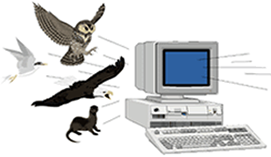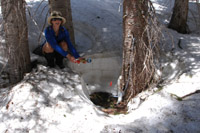- Home
- About S&T
- Taxa/Organisms
- Ecosystems
- Issues
- Methods & Tools
- Reports & Publications
- Location
- Search
Publisher: USGS | Science Center: Patuxent Wildlife Research Center (PWRC, Laurel) | Format: URL
www.pwrc.usgs.gov — Information about ecotoxicological exposure and its effects on terrestrial vertebrates residing in estuarine and coastal habitats like the Atlantic, Gulf and Pacific Coasts, Alaska and Hawaii, as well as the Great Lakes. These vertebrates include birds, mammals, amphibians and reptiles. The data is a compilation of results from computerized More...

Publisher: USGS | Science Center: Patuxent Wildlife Research Center (PWRC, Laurel) | Format: URL
www.pwrc.usgs.gov — BEST Large River Fish Health Data Query Tool provides a simplified portal for accessing database that serves fish health endpoints measured through the Biomonitoring of Environmental Status and Trends (BEST) Project's Large River Monitoring Network (LRMN). The tool allows the user to search the database by species, chemical, river basin, sampling More...

Publisher: USGS | Science Center: Columbia Environmental Research Center (CERC, Columbia) | Format: URL
www.cerc.usgs.gov — The primary goal of the proposed research is to evaluate selenium and atrazine exposure and effects to fish, amphibians, and waterfowl that utilize the Refuge. The following subordinate objectives will be met to investigate selenium exposure and effects to wildlife on the Refuge: 1.Measure selenium concentrations and total organic content in More...

Publisher: USGS | Science Center: Fort Collins Science Center (FORT, Ft. Collins) | Format: URL
www.fort.usgs.gov — Encroaching development, overuse, and air- and waterborne contaminants from outside park boundaries are causing noticeable changes to water quality and ecosystem health and functioning. The Front Range metropolitan area from Fort Collins south to Colorado Springs includes 75 percent of Colorado's population and its most productive agricultural More...

Publisher: USGS | Science Center: Columbia Environmental Research Center (CERC, Columbia) | Format: URL
www.cerc.usgs.gov — The BFRS works cooperatively with team members from CERC and with faculty and graduate students of Department of Wildlife and Fisheries Sciences at Texas A&M University in research areas represented by the branch structure of the CERC including toxicology, ecology, biochemistry and physiology, environmental chemistry, ecogeography, and information More...

Publisher: NBII | Format: URL
www.nbii.gov — Natural resource managers face complex decisions that require a clear understanding of the status of wildlife populations and their habitats. Monitoring is key to making effective management decisions and evaluating the outcomes of those decisions. The goal of NRMP is to improve the accessibility of monitoring efforts to resource managers to aid More...

Publisher: USGS | Science Center: Fort Collins Science Center (FORT, Ft. Collins) | Format: URL
www.fort.usgs.gov — Natural Resource Monitoring Partnership (NRMP) is a collaborative effort by the natural resource management community to improve monitoring efforts in order to support effective evaluation and decision-making by sharing information on monitoring projects and protocols. The Natural Resource Monitoring Partnership was built for easy access to More...

Publisher: USGS | Science Center: Patuxent Wildlife Research Center (PWRC, Laurel) | Format: URL
www.pwrc.usgs.gov — Written summaries of biological characteristics and contaminant exposure and effects data for 38 coastal and estuarine terrestrial vertebrates are available. Species were selected based on their previous use in contaminant monitoring, their status as valued natural resources, or as representatives of taxonomic groups. Characterizations were More...
